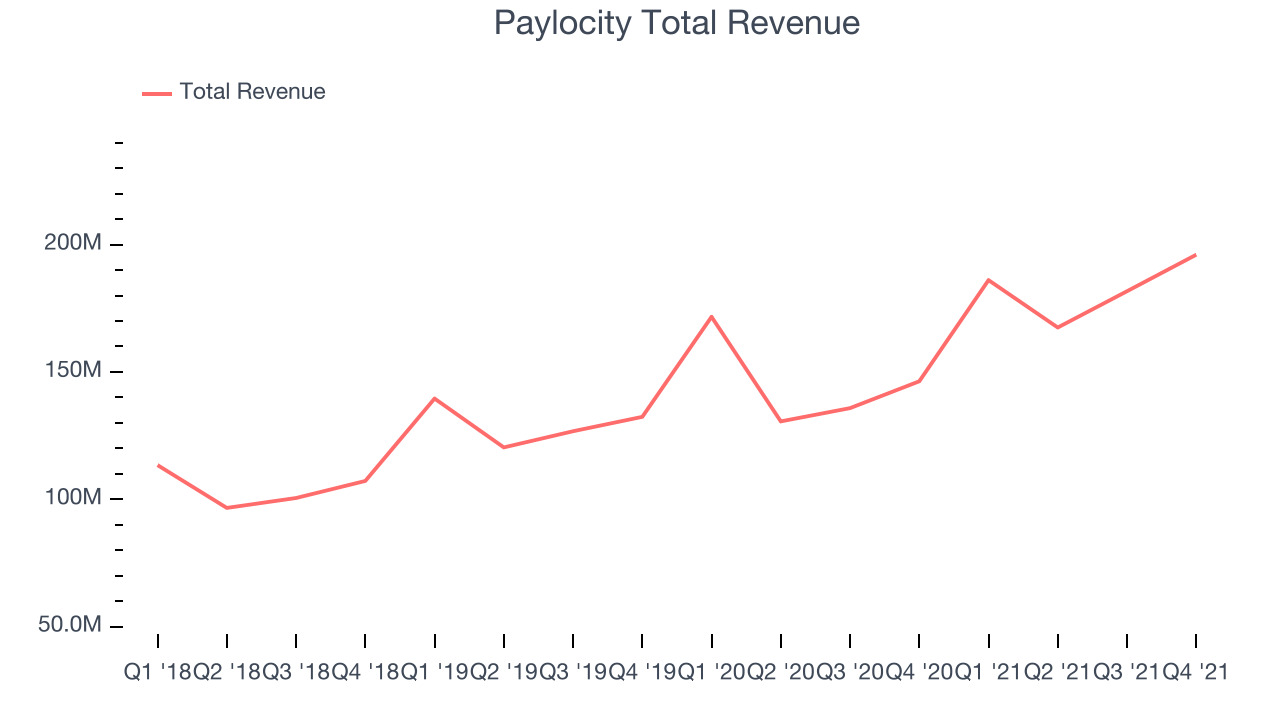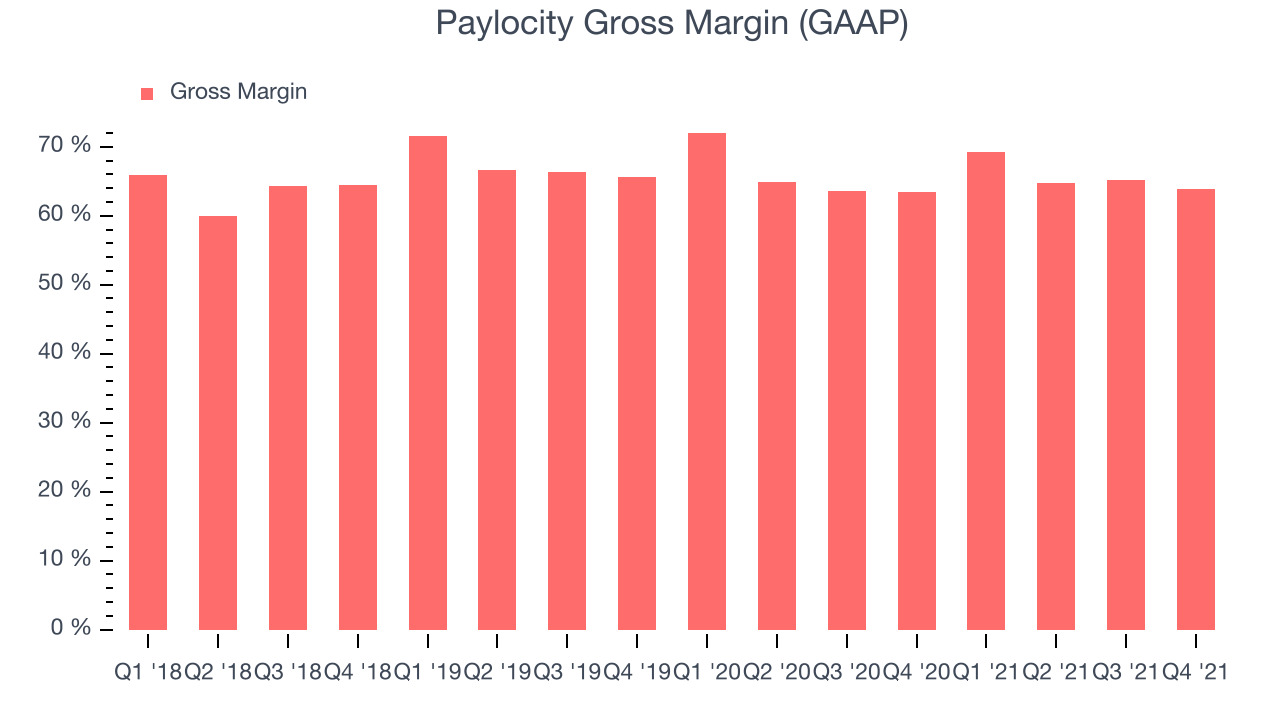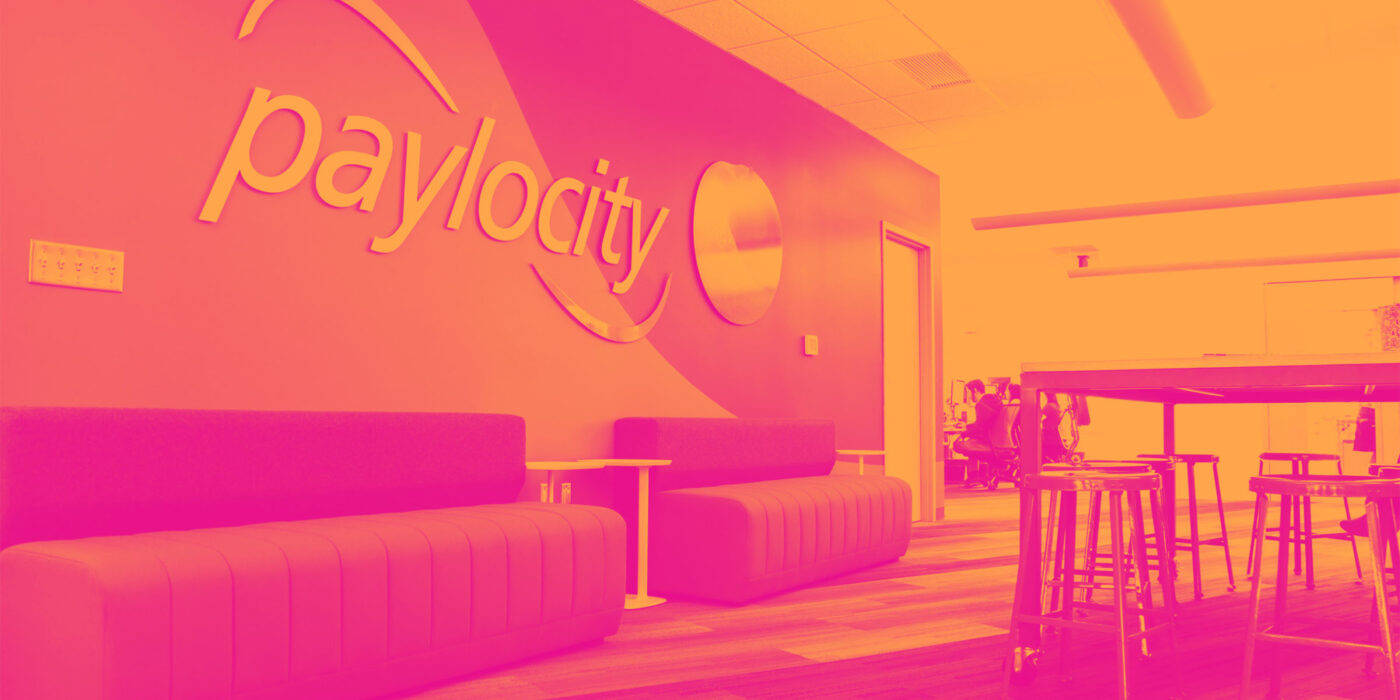Payroll and human resources software provider, Paylocity (NASDAQ:PCTY) announced better-than-expected results in the Q2 FY2022 quarter, with revenue up 33.9% year on year to $196 million. The company expects that next quarter's revenue would be around $241 million, which is the midpoint of the guidance range. That was in roughly line with analyst expectations. Paylocity made a GAAP profit of $9.85 million, improving on its profit of $9.64 million, in the same quarter last year.
Is now the time to buy Paylocity? Access our full analysis of the earnings results here, it's free.
Paylocity (PCTY) Q2 FY2022 Highlights:
- Revenue: $196 million vs analyst estimates of $188.2 million (4.11% beat)
- EPS (non-GAAP): $0.64 vs analyst estimates of $0.42 (53.2% beat)
- Revenue guidance for Q3 2022 is $241 million at the midpoint, roughly in line with what analysts were expecting
- The company lifted revenue guidance for the full year, from $817.5 million to $831.5 million at the midpoint, a 1.71% increase
- Free cash flow of $14.8 million, up from negative free cash flow of $16.5 million in previous quarter
- Gross Margin (GAAP): 63.8%, in line with same quarter last year
“Our differentiated value proposition of providing the most modern software in the industry, coupled with strong sales execution, resulted in our 2nd consecutive quarter of 34% revenue growth. Our sales teams continue to build momentum across all segments of our target market and delivered record selling season results, which position us very well headed into the back-half of the fiscal year. In January we also completed the acquisition of Cloudsnap, a low-code integration automation platform that enables the development and deployment of API integrations. Cloudsnap’s technology will enable Paylocity to deliver modern integrations and seamless data sharing between critical systems more efficiently and effectively, while helping to unify and automate business processes across HR, Finance, Benefits, and other systems,” said Steve Beauchamp, Chief Executive Officer of Paylocity.
Founded by payroll software veteran Steve Sarowitz in 1997, Paylocity (NASDAQ:PCTY) is a provider of payroll and human resources software for small and medium-sized enterprises.
HR software benefits from dual trends around costs savings and ease of use. First is the SaaS-ification of businesses, large and small, who much prefer the flexibility of cloud-based, web-browser delivered software paid for on a subscription basis than the hassle and expense of purchasing and managing on-premise enterprise software. Second is the consumerization of business software, whereby multiple standalone processes like payroll processing and compliance are aggregated into a single, easy to use platforms.
Sales Growth
As you can see below, Paylocity's revenue growth has been strong over the last year, growing from quarterly revenue of $146.3 million, to $196 million.

This was a standout quarter for Paylocity, with the quarterly revenue up 33.9% year on year, which is above average for the company. Quarter on quarter the revenue increased by $14.3 million in Q2, which was in line with Q1 2022. This steady quarter-on-quarter growth shows the company is able to maintain a strong growth trajectory.
Guidance for the next quarter indicates Paylocity is expecting revenue to grow 29.5% year on year to $241 million, improving on the 8.39% year-over-year increase in revenue the company had recorded in the same quarter last year. Ahead of the earnings results the analysts covering the company were estimating sales to grow 23.3% over the next twelve months.
There are others doing even better than Paylocity. Founded by ex-Google engineers, a small company making software for banks has been growing revenue 90% year on year and is already up more than 400% since the IPO in December. You can find it on our platform for free.
Profitability
What makes the software as a service business so attractive is that once the software is developed, it typically shouldn't cost much to provide it as an ongoing service to customers. Paylocity's gross profit margin, an important metric measuring how much money there is left after paying for servers, licenses, technical support and other necessary running expenses was at 63.8% in Q2.

That means that for every $1 in revenue the company had $0.63 left to spend on developing new products, marketing & sales and the general administrative overhead. This would be considered a low gross margin for a SaaS company and it has dropped significantly from the previous quarter, which is probably the opposite of what shareholders would like it to do.
Key Takeaways from Paylocity's Q2 Results
Sporting a market capitalization of $11 billion, more than $84.1 million in cash and with positive free cash flow over the last twelve months, we're confident that Paylocity has the resources it needs to pursue a high growth business strategy.
It was good to see Paylocity deliver strong revenue growth this quarter. And we were also excited to see that it outperformed Wall St’s revenue expectations. On the other hand, there was a deterioration in gross margin. Overall, this quarter's results seemed pretty positive and shareholders can feel optimistic. The company is flat on the results and currently trades at $197.06 per share.
Should you invest in Paylocity right now? It is important that you take into account its valuation and business qualities, as well as what happened in the latest quarter. We look at that in our actionable report which you can read here, it's free.
One way to find opportunities in the market is to watch for generational shifts in the economy. Almost every company is slowly finding itself becoming a technology company and facing cybersecurity risks and as a result, the demand for cloud-native cybersecurity is skyrocketing. This company is leading a massive technological shift in the industry and with revenue growth of 70% year on year and best-in-class SaaS metrics it should definitely be on your radar.
The author has no position in any of the stocks mentioned.
